
The Firespray-31
An X-Wing (TM) Strategy Article by Guest Writer Doug Kinney
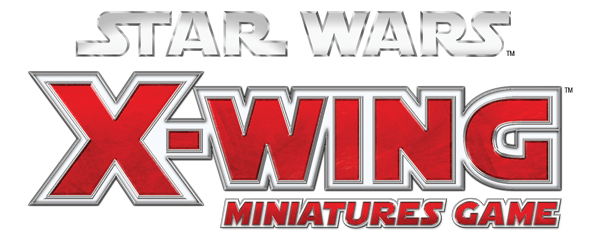
Nearly everyone in the Star Wars universe with a bounty on his head dreaded the idea that he might someday see Slave I show up on his sensors. Not only was its pilot, Boba Fett, one of the most ruthless and inventive bounty hunters in the galaxy, but the ship itself was a heavily modified Firespray-31 – fast, maneuverable, and loaded with firepower…
We continue our series of X-Wing™ strategy articles with a look at the Firespray-31 by one of the players most responsible for shaping its presence in the tournament environment, 2012 World Champion Doug Kinney.
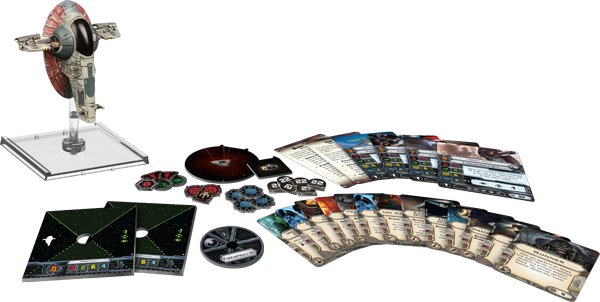
2012 World Champion Doug Kinney on the Firespray-31
Released in the second wave of X-Wing expansions, the Slave I Expansion Pack introduced the Firespray-31, one of the game’s two earliest large-base ships. Along with the Millennium Falcon, this ship has had a profound impact upon how the game is played.
Many people believe that the stock Firespray-31 is the most balanced ship in the game for both offense and defense. It boasts a primary weapon that fires a base of three dice and can be used in both the front and rear arcs. It can perform both the focus and target lock actions, and if it gains both tokens, it can become an offensive juggernaut. It shines on defense, as well, with a base agility value of “2” and the ability to perform the evade action. Plus, with a shield value of “4” and hull of “6”, even once it starts taking hits, it’s tough to take down.
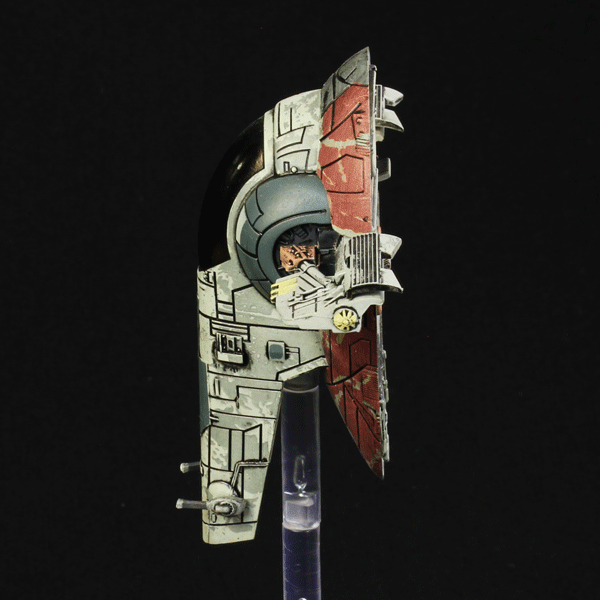
A 360-degree view of the Firespray-31. (Click to enlarge.)
Then, the Firespray-31 is highly customizable. You can load it out with a missile, a cannon, a bomb, and the Slave I Title even lets you add a torpedo. The Firespray-31 adds to these a myriad of good crew options, and both Kath Scarlet and Boba Fett also have elite pilot talent slots. So there are any number of good combinations to make your basic Firespray-31 a more imposing force. Alternatively, you can outfit it with crew members like Recon Specialist, Rebel Captive, or Flight Instructor to increase its defensive abilities.
And don’t forget that the Firespray-31 is a large-base ship! Its size gives it significant presence on the battlefield. At a pilot skill value of “3,” the Bounty Hunter can be an effective blocker against ships with higher pilot skill values, and the Firespray-31 is an especially effective blocker against the Rebellion’s heavy assault fighter, the B-wing. Even once you stop blocking, one of the greatest aspects of the Firespray-31 is that you can fly out of your enemies’ firing arcs and still attack with your auxiliary firing arc, meaning you can often attack without being attacked.
Flying the Firespray-31
For all its strengths, the Firespray-31 is not an easy ship to fly. There is a learning curve to being able to fly it well. I spent many weeks practicing before I was able to maneuver it effectively, and there are many good Imperial players that will attest that it takes a good amount of time to learn how the ship moves.
As you practice, you’ll want to see how the ship’s base serves as a guide to how far it will move when it performs certain maneuvers. For example, a turn with a speed of “2” will move your Firespray-31 only about half of a small-base width and length away from your starting position. That means if your ship is currently in contact with a small ship on its corner, you won’t be able to complete a speed “2” turn in that direction.
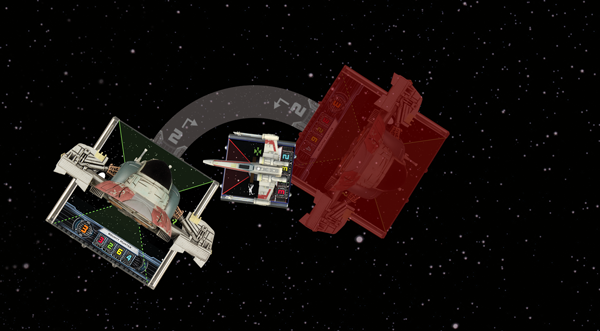
A Bounty Hunter fails to move past an X-wing with its speed “2” turn.
You will, however, be able to complete a speed “3” turn in that direction, as a speed “3” turn takes your ship a little bit wider and longer than the size of a small base away from your starting position. Making note of little tricks like that will help you learn to fly your Firespray-31 into and out of harm’s way during the heat of battle.
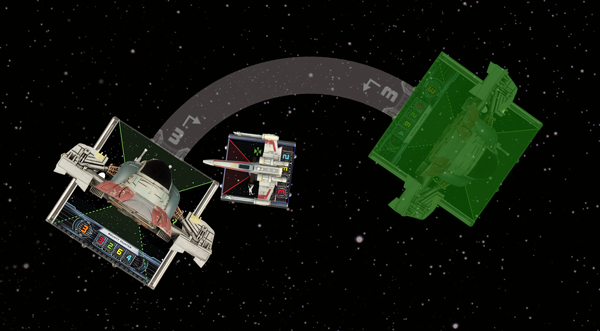
A Bounty Hunter clears an adjoining X-wing with its speed “3” turn.
Another hurdle you’ll need to clear is learning how best to use the auxiliary firing arc. The Firespray-31 is the only ship to-date with a printed rear firing arc, meaning it can fire its primary weapon either forward or backward. It was difficult for me to get out of the mindset that I needed to perform a Koiogran turn in order to attack, but I now use the rear arc as much as the primary arc – if not more so. It takes practice to maneuver while remaining cognizant of where your ship’s rear arc is facing, but once you get the maneuvering down, you will be able to continue your forward movement and perform actions, instead of performing Koigran turns, gaining stress tokens, and losing your actions.
The Firespray-31 in Imperial Squads
Many squads run a single Firespray-31, often complemented by a mini-swarm of TIE fighters, and when the metagame starts to shape up after the release of the fourth wave of starfighters that were announced a while back, I think you will see mini-swarms becoming increasingly popular. Thus, a squad with one Firespray-31 and a mini-swarm may be an increasingly popular archetype in the future.
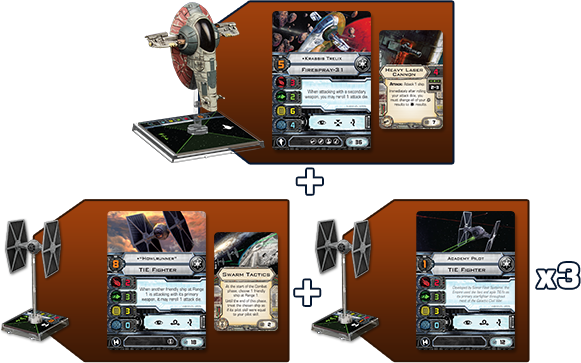
- Krassis Trelix (36) with Heavy Laser Cannon (7)
- “Howlrunner” (18) with Swarm Tactics (2)
- Academy Pilot (12)
- Academy Pilot (12)
- Academy Pilot (12)
Total Squad Points: 99
The Heavy Laser Cannon on Krassis packs a devastating punch and makes good use of his pilot ability. It also forces your opponent into the undesirable position of having to reconsider who to target first. Does he go after the big gun, leaving the mini-swarm to fire off volleys of quality attacks? Or does he go after the mini-swarm, leaving the big gun alone, letting it rain down shots of four dice each?
Meanwhile, you can line up your squad all together, or you can split your forces and attack in a type of pincer movement. I generally prefer to split my ships a little distance apart to allow myself room to maneuver my Firespray-31 without running afoul of the Academy Pilots.
One of the nice things about running a single Firespray-31 is that you generally have a lot of attacks on the board. The sample squad above boasts five separate attacks, which is a decent amount for an Imperial build. When you get into builds with two or three Firespray-31s, you will be getting some bigger bang for your attacks, but at the cost of a reduced number of attacks.
A number of other common squads run two Firespray-31s, and there are a few schools of thought on them. Some people build squads with just two fully loaded Firespray-31s, and they can be successful squads, like the example below:

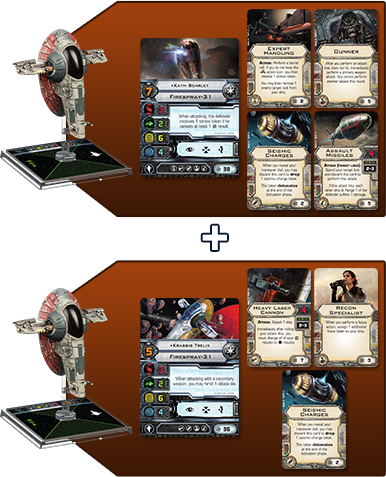
- Kath Scarlet (38) with Expert Handling (2), Gunner (5), Seismic Charges (2), and Assault Missiles (5)
- Krassis Trelix (36) with Heavy Laser Cannon (7), Recon Specialist (3), and Seismic Charges (2)
Total Squad Points: 100
This is a hard-hitting duo, and it comes with a little additional damage to help mitigate the fact that it only offers two attacks per round. Scott Williams, a player who has put this squad to good use in tournaments, designed an opening where he forces his opponent to chase Kath Scarlet while he chases his opponent with Krassis Trelix. Kath shoots out of her auxiliary arc, while Krassis uses his Heavy Laser Cannon to devastating effect.
Personally, I like to include a third ship in my squads for the extra attack and for drawing fire away from my Firespray-31s. One example is the squad that I took to second place at the 2013 Star Wars Game Experience, “Additional Damage”:
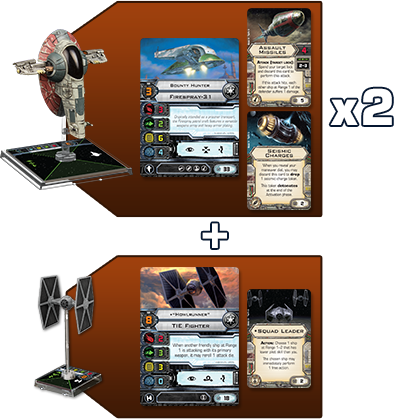
- Bounty Hunter (33) with Assault Missiles (5) and Seismic Charges (2)
- Bounty Hunter (33) with Assault Missiles (5) and Seismic Charges (2)
- “Howlrunner” (18) with Squad Leader (2)
Total Squad Points:
The “splash” damage from the Assault Missiles and the Seismic Charges allows you to pile damage onto your opponent on top of the damage you inflict with your standard attacks. However, it can be tough to keep the TIE fighter out of the way of the two Firespray-31s, especially if you’re trying to maximize the pilot ability of “Howlrunner.” TIE fighters and Firespray-31s have different size bases and usually have different pilot skill values, so keeping the TIE fighter out of the way of your Firespray-31s can be tricky, and that’s before you factor in your opponent’s ships.
Another list that makes good use of two Firespray-31s is a very powerful squad that Anthony Lillig took to the Top 16 at both the North American Championships and Worlds in 2013. It combines two Firespray-31s with two TIE fighters.
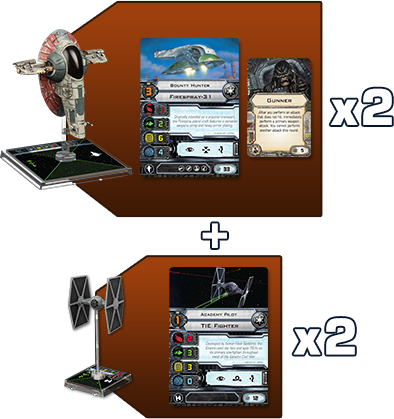
- Bounty Hunter (33) with Gunner (5)
- Bounty Hunter (33) with Gunner (5)
- Academy Pilot (12)
- Academy Pilot (12)
Total Squad Points: 100
It’s a simple, yet tough and effective, list that deals a lot of consistent damage. It has a great balance of offense and defense combined with action denial.
Of course, I would be remiss if I didn’t mention the squad that runs three Bounty Hunter Firespray-31s. (Yes, I can hear the collective groan of everyone who has had to fly against it.) This squad has no frills, just thirty points shields and hull and devastating combination of offense and defense. This squad is a bear to play against, especially when flown well, and Jacob Pichelmeyer, the reigning North American Champion, flew three Bounty Hunters to fourth place out of forty-six players at the 2013 Star Wars Game Experience.
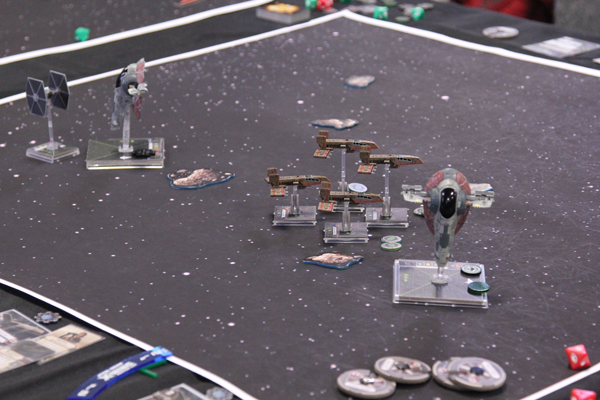
A squad with two Firespray-31s battles a squad of HWK-290s at Worlds 2013.
With its great balance of offense and defense, the Firespray-31 has had a major impact upon the shape of X-Wing, and the tremendous versatility afforded by its loaded upgrade bar ensures that it will continue to be an imposing force in the future.
Thanks, Doug!
Will you rely upon the balanced baseline statistics of the Firespray-31 to make the difference in your games of X-Wing? Will you discover clever and potent combinations of upgrades to hit enemy ships for more damage? Will you fly your Firespray-31 with a complement of TIE fighters, or will you pair it with other Imperial vessels?
Whether you run one Firespray-31 in your Imperial squad, or two, or three, we trust Doug’s advice will inspire you to explore more of the ways this ship can impact your games, and you can always find more advice and more discussion about this and other starships in our community forums!
…
